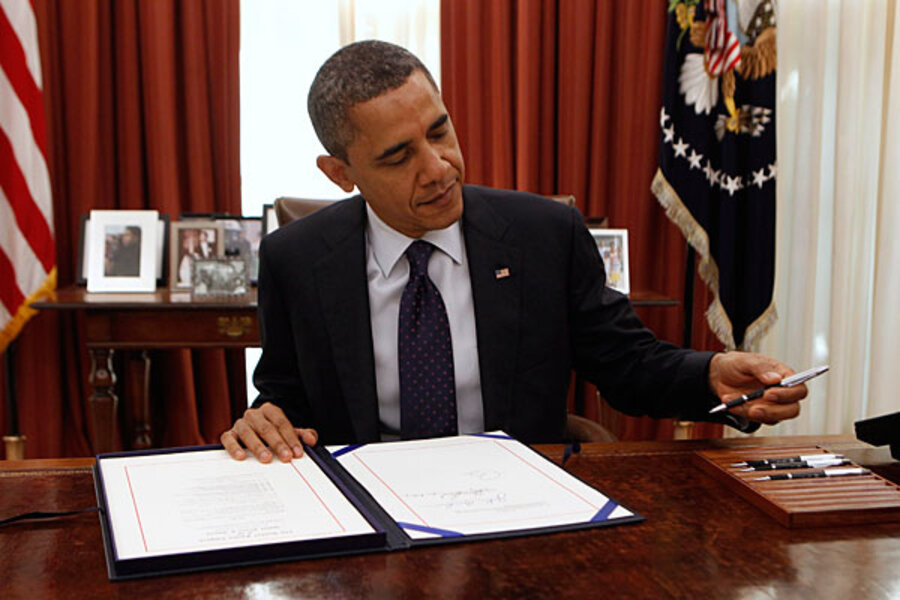Time to say goodbye to the payroll tax cut? It's looking that way.
Loading...
It now appears that all Americans with a job – no matter what their income level – will see their federal taxes rise on Jan. 1. That's because, in an effort to resolve the so-called "fiscal cliff," the Obama White House has quietly dropped its plan to extend the temporary 2 percentage point cut in payroll taxes, which are used to fund Social Security.
For someone who makes about $50,000 a year, the payroll tax will rise by about $19 a week, meaning that earner will have about $1,000 less to spend next year than in 2012. Some may make up for the lost income by eliminating that $4 latte every work day, or cutting back on the frequency of dining out at a sit-down restaurant.
“First paychecks [of the new year] will be about 2 percent smaller,” says Roberton Williams, a senior fellow at the Tax Policy Center in Washington. If someone's gross pay is $1,000 per week this year and all other taxes stay the same next year, that worker will take home $20 less a week in 2013.
That may not sound like much money, but for the economy as a whole the payroll tax cut amounted to about $112 billion in 2012 – or the equivalent of at least $300 for each person in the US.
“It’s money taken out of the economy that is not available to be spent,” says Mr. Williams.
All those cups of coffee and dinners out have added up to some extra hiring. In 2012, the payroll tax cut was expected to boost gross domestic product by 0.5 percent and 400,000 jobs, according to an August analysis by Macroeconomic Advisers, a St. Louis firm.
The payroll tax cuts date back to 2010, when President Obama proposed – and Congress agreed – to cut payroll taxes for individuals for one year, in a bid to help the country recover from the Great Recession. So, in 2011, the payroll tax went from 6.2 percent to 4.2 percent on the employee’s contribution to Social Security for earned income up to $110,000. The employer contribution of 6.2 percent remained unchanged.
Then, Congress and the president agreed to renew the payroll tax cut for 2012. Many budget analysts were surprised when Mr. Obama included it again for 2013.
“It was clearly a bargaining chip,” says Pete Davis of Davis Capital Investment Ideas, which advises Wall Street firms on Washington affairs. “And it was time to cash it in” during the fiscal cliff bargaining.
Getting Congress to agree to continue the payroll tax cut yet again might have been problematic. Many politicians, from Rep. Nancy Pelosi (D) of California to Sen. Orin Hatch (R) of Utah, were less than enthusiastic about extending it. That is in part because the money that would have come from wage earners’ pockets for Social Security was coming instead from the US Treasury’s general fund.
That is alarming to Pamela Tainter-Causey of the National Committee to Preserve Social Security & Medicare.
“We’re moving from a fund that is independent to one that is dependent on the general fund,” Ms. Tainter-Causey says of Social Security. “There could be a time when they say we can’t afford to put the money into Social Security this year.”
Some analysts also ask whether the payroll tax cut was a stimulus that actually served to create jobs. “If it was designed to encourage hiring, they should have done it on the employers’ side,” says Pamela Villarreal, a senior fellow at the National Center for Policy Analysis, a nonpartisan think tank in Dallas.
The analysis from Macroeconomic Advisers, however, disagreed. It said that decreasing employers’ payroll taxes would go right into profits and would be an “ineffective” way to increase hiring.
Ms. Villarreal suggests that it might be too soon to consider the payroll tax cuts kaput.
“To me, nothing is set in stone until the end of the year, until the fat lady sings,” she says. But for now, extending the payroll tax cut seems to be off the table.







